2018年春八年级英语下册Unit1What’sthematter(第1课时)习题课件人教新目标版
- 格式:ppt
- 大小:1.14 MB
- 文档页数:13

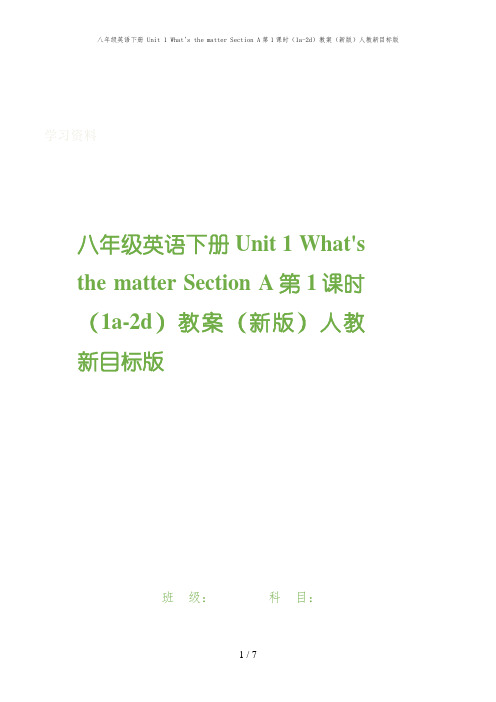
学习资料八年级英语下册 Unit 1 What'sthe matter Section A第1课时(1a-2d)教案(新版)人教新目标版班级:科目:Unit 1 What's the matter Section A第1课时(1a—2d)Section A 单词matter n.问题;事情stomachache n。
胃痛;腹痛foot n.脚;足neck n.颈;脖子stomach n。
胃;腹部throat n。
咽喉;喉咙fever n。
发烧lie v。
躺;平躺rest v。
& n。
放松;休息cough n。
& v。
咳嗽X—ray n。
X射线;X光toothache n.牙痛headache n。
头痛break n.间歇;休息hurt v。
(使)疼痛;受伤passenger n。
乘客;旅客off adv.& prep。
离开(某处);不工作;从……去掉onto prep.向;朝trouble n。
问题;苦恼hit v.(用手或器具)击;打herself pron.(she的反身代词)她自己短语have a cold 感冒have a stomachache 胃痛lie down 躺下take one’s temperature 量体温take breaks(take a break)休息have a fever 发烧to one’s surprise 使……惊讶的;出乎……意料get off 下车right away 立即;马上get into 陷入;参与句型1.—What’s the matter with Ben?本怎么了?—He hurt himself. He has a sore back。
他伤到了他自己,他背痛。
2。
—What should she do?她该怎么办?—She should take her temperature.她应该量下体温。
Section B 单词sick adj。
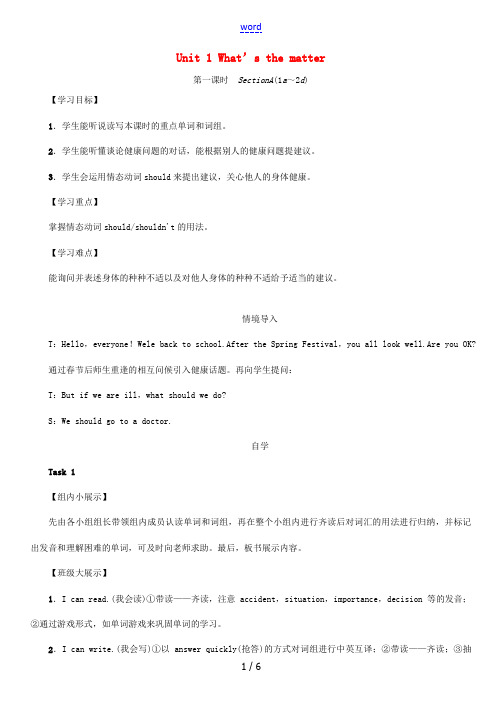
Unit 1 What’s the matter第一课时SectionA(1a~2d)【学习目标】1.学生能听说读写本课时的重点单词和词组。
2.学生能听懂谈论健康问题的对话,能根据别人的健康问题提建议。
3.学生会运用情态动词should来提出建议,关心他人的身体健康。
【学习重点】掌握情态动词should/shouldn't的用法。
【学习难点】能询问并表述身体的种种不适以及对他人身体的种种不适给予适当的建议。
情境导入T:Hello,everyone!Wele back to school.After the Spring Festival,you all look well.Are you OK?通过春节后师生重逢的相互问候引入健康话题。
再向学生提问:T:But if we are ill,what should we do?S:We should go to a doctor.自学Task 1【组内小展示】先由各小组组长带领组内成员认读单词和词组,再在整个小组内进行齐读后对词汇的用法进行归纳,并标记出发音和理解困难的单词,可及时向老师求助。
最后,板书展示内容。
【班级大展示】1.I can read.(我会读)①带读——齐读,注意accident,situation,importance,decision等的发音;②通过游戏形式,如单词游戏来巩固单词的学习。
2.I can write.(我会写)①以answer quickly(抢答)的方式对词组进行中英互译;②带读——齐读;③抽测:可以用造句的方式巩固词组的用法。
3.I can summarize.(我会总结)①结合I can write中的单词,总结归纳询问病情及其回答的用法;②抽测:用【小试牛刀】中的练习对询问病情的用法进行巩固,并以抢答的方式对答案进行核对,并进行讲解。
情景导入生成问题1.(T)Question:Are you OK?What should we do to keep healthy?(S)Answer:________________________________________________________________________2.(T)Question:But if we are ill,what should we do?(S)Answer:________________________________________________________________________自学互研生成能力Task 1Let's read the new words and phrases.1.I can read.(我会读)matter,sore,throat,stomachache,foot,neck,stomach,fever,lie,rest,Xray,toothache,headache,cough2.I can write.(我会写)(1)What's the matter? 怎么了?__ (2)have a very sore throat 喉咙很痛(3)talk too much 说话太多 (4)lie down and rest 躺下休息(5)drink some hot tea with honey 喝一些带蜂蜜的热茶(6)see a dentist 看牙医(7)get an Xray 拍X光(8)take one's temperature 量体温 (9)cut oneself 割伤自己(10)put some medicine on it 在上面敷药(11)have a fever 发烧 (12)have a headache 头痛(13)sound like 听起来像 (14)on the weekend 在周末(15)play puter games 玩电脑游戏 (16)all weekend 整个周末(17)take breaks 休息 (18)go to a doctor 看医生3.I can summarize.(我会总结)(1)What's the matter?这是人们,特别是医生和护士,询问病人病情时最常用的句型,意思是“怎么了?”其后通常与介词 with 连用。
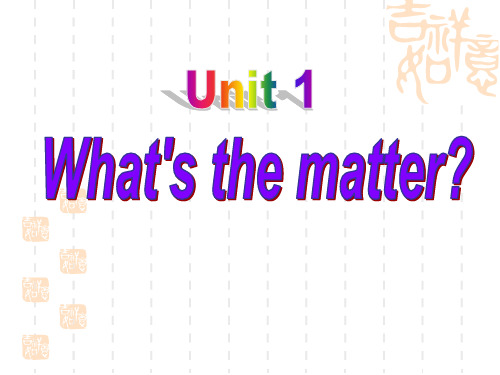
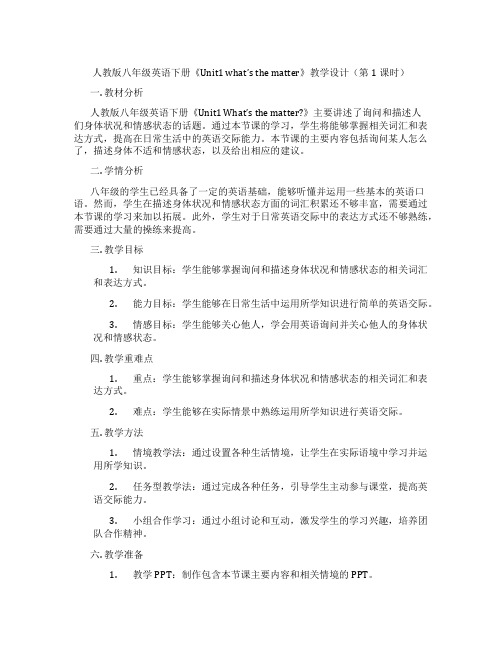
人教版八年级英语下册《Unit1 what’s the matter》教学设计(第1课时)一. 教材分析人教版八年级英语下册《Unit1 What’s the matter?》主要讲述了询问和描述人们身体状况和情感状态的话题。
通过本节课的学习,学生将能够掌握相关词汇和表达方式,提高在日常生活中的英语交际能力。
本节课的主要内容包括询问某人怎么了,描述身体不适和情感状态,以及给出相应的建议。
二. 学情分析八年级的学生已经具备了一定的英语基础,能够听懂并运用一些基本的英语口语。
然而,学生在描述身体状况和情感状态方面的词汇积累还不够丰富,需要通过本节课的学习来加以拓展。
此外,学生对于日常英语交际中的表达方式还不够熟练,需要通过大量的操练来提高。
三. 教学目标1.知识目标:学生能够掌握询问和描述身体状况和情感状态的相关词汇和表达方式。
2.能力目标:学生能够在日常生活中运用所学知识进行简单的英语交际。
3.情感目标:学生能够关心他人,学会用英语询问并关心他人的身体状况和情感状态。
四. 教学重难点1.重点:学生能够掌握询问和描述身体状况和情感状态的相关词汇和表达方式。
2.难点:学生能够在实际情景中熟练运用所学知识进行英语交际。
五. 教学方法1.情境教学法:通过设置各种生活情境,让学生在实际语境中学习并运用所学知识。
2.任务型教学法:通过完成各种任务,引导学生主动参与课堂,提高英语交际能力。
3.小组合作学习:通过小组讨论和互动,激发学生的学习兴趣,培养团队合作精神。
六. 教学准备1.教学PPT:制作包含本节课主要内容和相关情境的PPT。
2.教学素材:准备一些描述身体状况和情感状态的图片或卡片。
3.教学录音设备:用于播放听力材料。
七. 教学过程1.导入(5分钟)教师通过播放一段关于人们描述身体状况和情感状态的听力材料,引导学生关注本节课的主题。
同时,教师可以提问学生:“Can you guess what’s the matter with them?”,激发学生的学习兴趣。
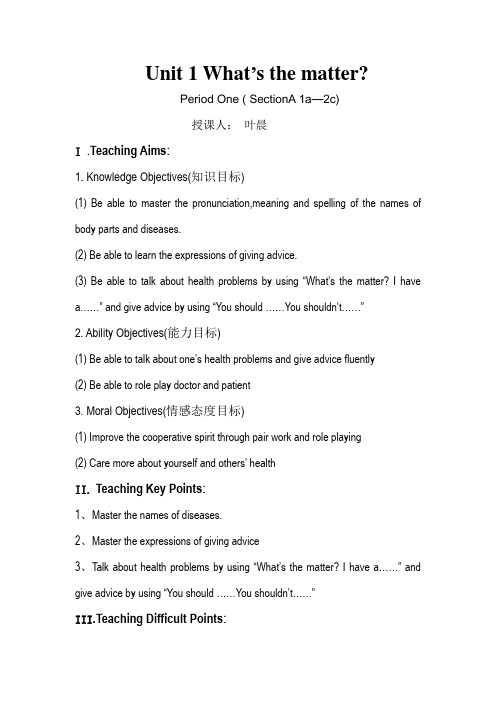
Unit 1 What’s the matter?Period One ( SectionA 1a—2c)授课人:叶晨I .Teaching Aims:1. Knowledge Objectives(知识目标)(1) Be able to master the pronunciation,meaning and spelling of the names of body parts and diseases.(2) Be able to learn the expressions of giving advice.(3) Be able to talk about health problems by using “What’s the matter? I have a……” and give advice by using “You should ……You shouldn’t……”2. Ability Objectives(能力目标)(1) Be able to talk about one’s health problems and giv e advice fluently(2) Be able to role play doctor and patient3. Moral Objectives(情感态度目标)(1) Improve the cooperative spirit through pair work and role playing(2) Care more about yourself and others’ healthII. Teaching Key Points:1、Master the names of diseases.2、Master the expressions of giving advice3、Talk about health problems by using “What’s the matter? I have a……” and give advice by using “You should ……You shouldn’t……”III.Teaching Difficult Points:1、Students may find it difficult to remember all the target new words in the class2、Students may find it difficult to give appropriate advice to the certain disease because of their limited life experience.IV.Teaching AidsCards, a doll, pptV. Teaching Methods:1. Inferring vocabulary2. Role play ;Guessing game; Group and pair work3. Task-based teaching and situation-based teachingVI. Teaching procedures:Step1.Lead--in1. Enjoy a Chinese song: 健康歌2. The teacher(T) shows the doll bear and a picture of Pan Changjiang,point to the parts of the body3. Guessing a game : Listen and point the parts of bodyStep2. PresentionFinish 1a .1.Read the words about the parts of the body together.2.Write the correct letter [a-m] for each part of the body3.Invite a student to show your answer and the check it.Step3. Finish the four tasksTask 1 Look (望) and Listen (闻)Show the key vocabulary1.Learn the words and the phrases about illness. Have a cold/stomachache/headache/toothache/fever/sore throat/….2. Let’s match. Translation. Boys PK girls.3. Let’s act. Do and Say. See the doctor.First, the teacher hand out one phrase about illness to every group, then the teacher ask as a doctor ,“Cold, cold ,who has a cold ?” If the first group get the phrase “have a cold”, the SS in the group are doing action while answering,“Cold, cold, I have a cold.” .4. Let’s chantTask 2 Ask(问)Show the target languageFinish 1b&1c1. T: If you are a doctor, how to ask a patient?(T leads the Ss )Ss: --What’s the matter with…?/ What’s wrong with….?--I have…..T: What’s the matter the patie nts in the picture?Listen and then number the names[1—5]2. Ask a student to tell the answer, and then teacher checks it.3. Read after the tape, then read after the teacher, read together4. Pair work. Give Ss 4 minutes to make the conversations with their partnersaccording to 1b using the target language---What’s the matter with? ---She/He has …..Task 3Advice (切)Show how to give some adviceFinish 2a&2b1.T:Oh, my god ,I have a headache now. Do you know why ?S1: You have a cold.T : No, I don’t have a cold. I only have a headache. Guess again.S2 : You watched TV and played computer games too late last night.T: You’re so clever. Can you give me advice? You can use“You should …or You shouldn’t …” What should I do ?S2 :You should lie down and rest .T: But should I lie down and rest now ? Of course not. Because I am giving an English class now. What shouldn’t I do ?S3 : You shouldn’t watch TV or play computer games too much .T: Thank you for your advice.2. Listening practice(1)Listen for the first time, number the pictures [1--5]in the order you hearthem .For the second time, match the problems with the advice.(2)Check the answers and read after the tape.Task 4 Internship (实习)Finish 2c. Speaking practiceGroup workTwo or three Ss in a group make conversations according to the example in 2c or in the screen. Give Ss 5 minutes and then act out.Step 5 Summary and ConsolidationLet’s summarize what we’ve learned. Today we’ve learned some parts of our body and learned how to ask the patients and give them advice. Please pay attention to the modal word should .No matter what your advice is, you must use should or shouldn’t. Let’s enjoy the sentences :(1)We shouldn’t watch TV or play computer games too much .(2) An apple a day keeps a doctor away. (3) Health is more important than wealth.Step6 Homework1. Remember the words and the phrases about illness2. Write some advice on keeping healthy.。
Unit 1 What’s the matter?教学目标:1语言目标:描述健康问题的词汇,及如何根据别人的健康问题提建议。
2 技能目标:能听懂谈论健康问题的对话材料;能根据别人的健康问题提建议;能写出重点单词和重点句型,并能描述怎样对待健康问题。
3 情感目标:通过开展扮演病人等活动,培养学生关心他人身体健康的品质。
通过本课的阅读,培养学生处理紧急事件的基本能力,树立紧急事件时互相帮助的精神。
教学重点:短语: have a stomachache, have a cold, lie down, take one’s temperature,go to a doctor, get off, to one’s surprise, agree to do sth., get into trouble,fall down, be used to, run out (of), cut off , get out of, be in control of ,keep on (doing sth.), give up句子:1 What’s th e matter? I have a stomachache. You shouldn’t eat so much next time.2 What’s the matter with Ben?He hurt himself. He has a sore back.He should lie down and rest.3 Do you have a fever? Yes, I do. No, I don’t.I don’t know.4 Does he have a toothache? Yes, he does.He should see a dentist and get an X-ray.5 What should she do? She should take her temperature.6 Should I put some medicine on it? Yes, you should No, you shouldn’t.教学难点:掌握情态动词should \shouldn’t. 的用法学习have的用法课时划分:Section A1 1a – 2dSection A2 3a-3cSection A3 Grammar Focus-4cSection B1 1a-2eSection B2 3a-Self checkSection A 1 (1a – 2d)Step 1 Warming up and new words1.Look at a picture and learn the parts of the body.2.New words and phrases.Step 2 Presentation1a Look at the picture. Write the correct letter [a-m] for each part of the body.___arm ___ back ___ ear ___ eye ___ foot ___hand ___ head ___ leg ___ mouth___ neck ___nose ___ stomach ___ toothStep 3 Listening1b Listen and look at the picture. Then number the names 1-5 Listen to the conversations again and fill in the blanks.Conversation 1Nurse: What’s the matter, Sarah?Girl: I ___________.Conversation 2Nurse: What’s the matter, David?Boy: I _________________.Conversation 3Nurse: What’s the matter, Ben?Boy: I _________________.Conversation 4Nurse: What’s the matter, Nancy?Girl: I _________________.Conversation 5Betty: What’s th e matter, Judy?Ann: She __________________.Step 4 Speaking1c Look at the pictures. What are the students’ problems? Make conversations.ExamplesA: What’s the matter with Judy?B: She talked too much yesterday and didn’t drin k enough water.She has a very sore throat now.A: What’s the matter with Sarah?B: She didn’t take care of herself on the weekend. She was playing with her friends at the park yesterday. Then it gotwindy, but she didn’t put on her jacket. Now she has a cold. Step 5 Guessing gamesGuess what has happened to the students by using the important sentences.Step 6 Listening2a Listen and number the pictures [1-5] in the order you hear them. 2b Listen again. Match the problems with the advice.Step 7 Speaking2c Make conversations using the information in 2a and 2bA: What’s the matter?B: My head feels very hot.A: Maybe you have a fever.B: What should I do?A: You should take your temperature.Step 8 Role–playImagine you are the school doctor. A few students have health problems. Role-play a conversation between the doctor and the students.2d Role –play the conversationStep 9 Language points and summary1. What’s the matte r?这是人们特别是医生和护士询问病人病情时最常用的问句, 意思是“怎么了?”其后通常与介词with连用。
人教版八年级下册英语课本知识点梳理Unit 1 wh at’s the matter? sectionA课文内容:What's the matter? 怎么了? (教材第1页)【用法详解】What's the matter? 怎么了?/出什么事了?常用于询问某人患了何种疾病,遇到了什么困难等,也可用于询问某物出了什么故障,其后可接with sb./sth.,表示“某人/某物怎么了?”。
其中matter 用作名词,意为“问题;事情”matter前须加定冠词the。
【例句】What's the matter? 怎么了?Bad luck.I lost my pen. 真倒霉,我弄丢了钢笔.What's the matter with him? 他怎么了?He has a sore back.他背痛【拓展】matter[动词] 要紧;有关系多用在否定句、疑问句或条件句中It doesn't matter.没关系。
(通常用来回答对方的道歉)I have a cold. 我感冒了。
(教材第1页)【用法详解】have a cold (患)感冒。
其中have 用作及物动词,意为“患(病);遭受(病痛)”,常用于结构“have a/an +疾病名称”表示患病或身体某部位不舒服。
此时它不能用于进行时态,其第三人称单数形式为has,过去式为had。
常见的表示病痛的短语还有:have a fever 发烧have a toothache 牙疼have a headache头痛have a cough 咳嗽have a stomachache胃痛Do you often have a cold? 你经常感冒吗?Jim had a stomachache after supper yesterday.吉姆昨天晚饭后胃痛。
l have a stomachache.我胃痛。
( 教材第1 页)【用法详解】stomachache [名词]胃痛;腹痛是由“名词stomach(;腹部)+ache(疼痛)”构成的复合名词。